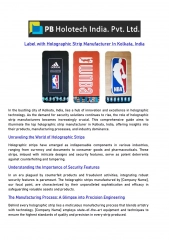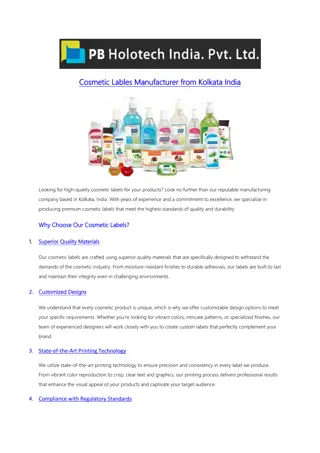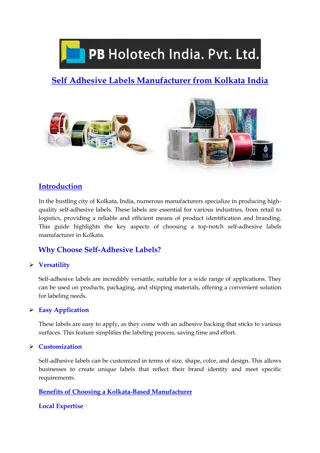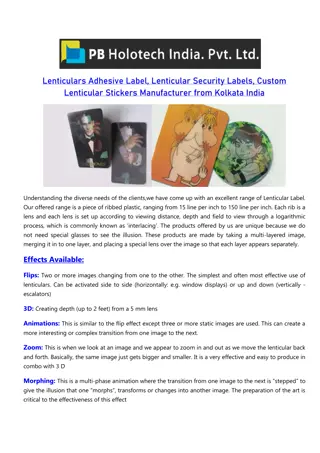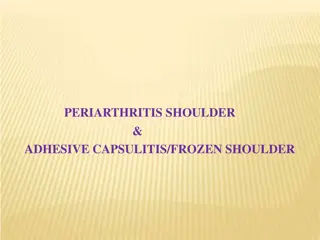Adhesive Capsulitis
This presentation covers key aspects of adhesive capsulitis, including risk factors, evaluative tools for diagnosis, phases of the condition, and treatment ideas. It explores the anatomy involved, predisposing factors, and pathophysiology of adhesive capsulitis.
Download Presentation

Please find below an Image/Link to download the presentation.
The content on the website is provided AS IS for your information and personal use only. It may not be sold, licensed, or shared on other websites without obtaining consent from the author. Download presentation by click this link. If you encounter any issues during the download, it is possible that the publisher has removed the file from their server.
E N D
Presentation Transcript
Adhesive Capsulitis By: AJ Francioni 3rdYear DPT UNC Chapel Hill With the assistance of Dr. McMorris
Learning Objectives Recognize at least 3 risk factors for Adhesive Capsulitis Recognize at least 3 evaluative tools to diagnose Adhesive Capsulitis Be able to identify the phases of Adhesive Capsulitis Be able to identify at least 3 treatment ideas for Adhesive Capsulitis
Adhesive Capsulitis GHJ capsular fibrosis with chronic inflammation Primary No specific, precipitating event (Believed) chronic inflammation with fibroblastic proliferation Secondary After surgery or injury Potential associated conditions Diabetes, RC injury, CVA, cardiovascular disease, thyroid Incidence = 5-percent of general population1 As much as 20-percent for people with diabetes1
Anatomy to Consider2 GHJ encased by capsule, which has 2 layers External = dense, fibrous connective tissue Inner = protein collagen Synovial membrane if fluid is underproduced ROM loss Capsule is strongest superiorly restricts rotation Ligaments thicken capsule anteriorly restricts external rotation Capsular Pattern = ER > AB > IR Common finding through imaging = coracohumeral ligament becomes stiffer
Postero-Inferior view of shoulder dissection to demonstrate the anterosuperior glenohumeral capsule.3
Predisposing Factors Middle age (40-59 years)4 Female4 Diabetes Mellitus1 Thyroid disease1 Trauma1 Autoimmune disease1 Cerebrovascular disease, CAD, MI1 Sedentary lifestyle5 Past h/o Adhesive Capsulitis Prolonged immobilization2 Patient Education Modifiable Risk Factors Level of Complexity Adherence to HEP
Pathophysiology Inflammation + Fibrosis = pain and stiffness Accepted pathology Contracture of GH capsule1 Loss of synovial layer1 Adhesions of axillary tissue to itself1 Decreased capsular volume1 Fascial restrictions, muscle tightness, and trigger points Current Hypothesis = inflammation in joint capsule and synovial fluid allow for fibrosis and adhesions in synovial lining4
Glenohumeral capsule during the frozen phase of adhesive capsulitis6
Differential Diagnosis1,4 Septic arthritis Chronic Regional Pain Syndrome Fracture Shoulder Girdle tumors Rotator Cuff pathology Tendonitis/bursitis GH arthrosis Fibromyalgia Shoulder impingement Disease of digestive system Cervical radiculopathy
Four Stages Stage 1 = up to 3 months Stage 2 = Painful Freezing Stage lasts from 3-9 months4 Stage 3 = Frozen Stage lasts from 9-15 months4 Stage 4 = Thawing Stage lasts from 15-24 months4
Stage 1 Up to 3 months Sharp pain at end of ROM Can be mistaken for impingement d/t greater motion still available Achy pain at rest Sleep disturbance
Stage 2 Freezing Lasts 3 to 9 months1 Inflammation/synovitis1 Present with diffuse shoulder pain or stiffness4 More active at night Gradual loss of motion d/t pain
Stage 3 - Frozen Lasts 9 to 15 months4 Pain and ROM loss d/t adhesions and synovial proliferation1 Capsular Pattern = ER > AB > IR Stage 4 Thawing Lasts 15-24 months4 Recovery phase with gradual return of ROM 20-50 percent of patients will have lasting symptoms past this phase1 Pt education for adherence and follow-through
Evaluation and Examination Objective Clear cervical spine Active and Passive ROM Compare sides Strength Shrug sign with GH elevation Special Tests:4 Neer Hawkins-Kennedy Outcome Measures Signs and Symptoms Gradual onset of pain progressively worse Guarding or protect it by reducing movement Difficulty with UE focused tasks Sleep disturbance Night pain
Outcome Measures7 Self-reported measures asking about ADL s and functional tasks Disabilities of the Arm, Shoulder, and Hand (DASH) American Shoulder and Elbow Surgeons shoulder scale (ASES) Shoulder Pain and Disability Index (SPADI) Reaching overhead Sleeping on affected side Washing hair Carrying heavy object
Conservative Interventions NSAIDS Oral corticosteroids Modalities to relieve inflammation Physical therapy
Physical Therapy Painful Freezing Stage PROM to maintain existing ROM and relieve muscle involvement6 Postural positioning8 Grade I/II mobs and long axis distraction1,4
Physical Therapy Frozen and Thawing AAROM8 Capsular stretching1 Progressive resistance training in pain- free range4 HEP Stretching8 Scapular and RC strengthening
Referrals and Discharge Orthopedic specialist No improvements of symptoms or functional mobility within 6 months9 Educate patient on expectations Co-morbidities can affect perceived outcomes and timeliness of progress Long-term disability 10-20 percent4 Persistent Symptoms 30-60 percent4 Educate on importance of persistence with HEP Consider the biopsychosocial model when treating
Procedural Interventions GH intra-articular corticosteroid injection Fast relief by reducing inflammation, but effects may only last 4-6 weeks 7 Hydrodilation Inject large volume of fluid to increase intracapsular volume and stretch capsule 1,4,6 Manipulation under anesthesia Capsule or scar tissue stretches or tears6 Arthroscopic surgery Risk d/t period of immobilization required6
The Interactive Part of Learning Objectives List at least 3 risk factors for Adhesive Capsulitis List at least 3 evaluative tools to diagnose Adhesive Capsulitis Explain the phases of Adhesive Capsulitis Provide at least 3 treatment ideas for Adhesive Capsulitis
References 1. Le HV, Lee SJ, Nazarian A, Rodriguez EK. Adhesive capsulitis of the shoulder: review of pathophysiology and current clinical treatments. Shoulder Elbow 2017;9(2):75-84. doi:10.1177/1758573216676786. 2. Carmichael SW, Hart DL. Anatomy of the shoulder joint. J. Orthop. Sports Phys. Ther. 1985;6(4):225-228. doi:10.2519/jospt.1985.6.4.225. Duke Anatomy - Lab 16: Upper & Lower Limb Joints. Available at: https://web.duke.edu/anatomy/lab16/lab16.html. Accessed December 4, 2018. St Angelo JM, Fabiano SE. Adhesive Capsulitis. In: StatPearls. Treasure Island (FL): StatPearls Publishing; 2018. Rauoof MA, Lone NA, Bhat BA, Habib S. Etiological factors and clinical profile of adhesive capsulitis in patients seen at the rheumatology clinic of a tertiary care hospital in India. Saudi Med J 2004;25(3):359-362. Frozen Shoulder - Adhesive Capsulitis - OrthoInfo - AAOS. Available at: https://orthoinfo.aaos.org/en/diseases-- conditions/frozen-shoulder/. Accessed December 4, 2018. Kelley MJ, Shaffer MA, Kuhn JE, et al. Shoulder pain and mobility deficits: adhesive capsulitis. J. Orthop. Sports Phys. Ther. 2013;43(5):A1-31. doi:10.2519/jospt.2013.0302. Chan HBY, Pua PY, How CH. Physical therapy in the management of frozen shoulder. Singapore Med J 2017;58(12):685- 689. doi:10.11622/smedj.2017107. Neviaser AS, Neviaser RJ. Adhesive capsulitis of the shoulder. J Am Acad Orthop Surg 2011;19(9):536-542. 3. 4. 5. 6. 7. 8. 9.






